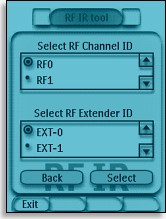|
...Continued from Page 20.
All buttons on the TSU3000 also have a troubling lag between the time they are pressed and the time the command is finally transmitted. While most remotes (including the original Pronto) operate on an instantaneous basis � the instant you make contact with the button is the instant the command begins transmitting � the Pronto NG has a quarter to half second delay on both LCD and hard buttons. The remote beeps instantly, but the command isn�t sent until later. Worse still, if buttons are tapped too quickly some commands are dropped � even if the remote beeped for each. Enter the digits for channel �185� in rapid succession and you may get channel �15�. Finally, the minimum transmit time on the TSU3000 is slightly longer than previous Prontos, further impacting how quickly buttons can be sequentially pressed.
Infrared hide and seek.
Everyone doesn�t store their home theater equipment openly beneath their television � many systems have components located in a cabinet, off to the side, behind the main seating area or even in a separate room. If this describes you, then you�ll already know that in those instances infrared-based remotes are essentially useless as light can�t turn corners or go through opaque objects. The TSU3000�s powerful emitters do give the remote a fair bit of control over exposed off-center equipment in the same room, but for all other circumstances Philips provides the optional $149 RFX6000 radio frequency (RF) extender.
The RFX6000 doesn�t add the capability of controlling actual RF equipment, such as many DSS receivers and Bose hifi systems, but instead allows one to control traditional infrared equipment over a radio frequency network. The Pronto NG transmits a command to the RFX6000 in radio frequency and then the RFX6000 retransmits it as infrared. The transceiver is an extraordinarily small grey box that measures just 4.4� wide, 3.1� deep and 1.1� thick (11.2cm by 7.9cm by 2.8cm). There�s no external antenna like most competing RF systems � everything�s enclosed.
The RF receiver has four built-in (but less powerful) infrared emitters, two based on front and two on top. It also includes wall or table mounting hardware, so depending on where it�s placed it can broadcast over a fairly large area. The right side of the unit has a DC power-in jack for the bundled wall wart, plus two small dials that adjust its settings � 16 IDs plus 4 channels for operation. A small LED indicates when it has power and flickers when transmitting.

RF settings. |
The left side of the extender has four small headphone-style jacks for wired infrared emitters. The unit ships complete with four cables that each end in dual self-sticking emitters, so ignoring the �wideband� transmitter the extender is capable of controlling 8 devices by wire. It is not possible to specify a particular emitter, but up to 16 individually identified extenders can be added to a single system. RF is configured on the remote or in ProntoEdit NG, individually for each device or system-wide, to either RF or infrared but not both at once.
In some situations it�s possible to operate the RFX6000 from over one hundred feet away, compared to an average maximum infrared distance of 30 feet. However, RF is a picky beast that�s unreliable in nature. Users with thick walls, lots of wiring or a very busy radio spectrum might experience difficulties from just a few feet away from the extender. In my situation the extender functioned well from 50 or 60 feet away (the furthest I could realistically test from), but that�s far from a guarantee that it will work in your particular conditions.
| 
